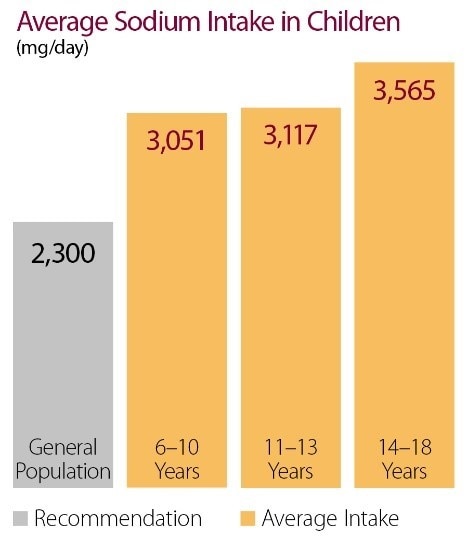Sodium, Potassium and Health
Potassium and sodium are electrolytes that help your body function normally by maintaining fluid and blood volume. However, consuming too little potassium and too much sodium can raise your blood pressure.
Though the words salt” and “sodium” are often used interchangeably, they do not mean the same thing. Salt (also known by its chemical name, “sodium chloride”) is a crystal-like compound that is common in nature. Sodium is a mineral, and one of the chemical elements found in salt.
Most potassium we eat naturally occurs in vegetables, fruit, seafood, and dairy products. On the other hand, most sodium we eat is added to packaged and restaurant foods.

What We Eat in America, National Health and Nutrition Examination Survey, 2011-2012
Potassium, Sodium, High Blood Pressure, Heart Disease, and Stroke
Increasing potassium intake can help decrease your blood pressure if you have high blood pressure. By lowering blood pressure, increasing potassium intake can also reduce your risk for heart disease and stroke. In contrast, consuming too much sodium can raise your blood pressure. Limiting sodium intake is especially important if you have high blood pressure, also known as hypertension. High blood pressure increases your risk of heart disease and stroke.
Sodium and Children
Nearly 9 in 10 US children eat more sodium than recommended and about 1 in 9 children has raised blood pressure, a major risk factor for heart disease and stroke. Lowering sodium in children’s diets can help lower blood pressure and may prevent heart disease later in life.
Potassium in the Food Supply and Potassium Intake

Most Americans eat too little potassium and too much sodium. Some good sources of potassium include bananas, oranges and melons, cooked spinach and broccoli, and potatoes and sweet potatoes.
The majority of sodium in our diets comes from packaged and restaurant food (not the salt shaker) as a result of food processing. Even foods that may not taste salty can be major sources of sodium. Foods with only moderate amounts of sodium, such as bread, can be major sources of sodium because they’re eaten so frequently. Americans consume more than 3,400 milligrams (mg) of sodium each day, on average. This is well above the 2020-2025 Dietary Guidelines for Americans recommendation.
You can find potassium and sodium content, and percent Daily Values (%DV) on Nutrition Facts Labels for packaged foods.
